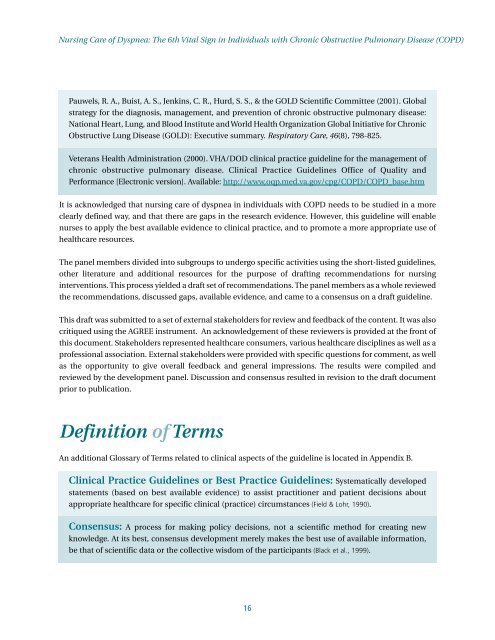Nursing Care of Dyspnea: The 6th Vital Sign in Individuals with ...
Nursing Care of Dyspnea: The 6th Vital Sign in Individuals with ...
Nursing Care of Dyspnea: The 6th Vital Sign in Individuals with ...
Create successful ePaper yourself
Turn your PDF publications into a flip-book with our unique Google optimized e-Paper software.
<strong>Nurs<strong>in</strong>g</strong> <strong>Care</strong> <strong>of</strong> <strong>Dyspnea</strong>: <strong>The</strong> <strong>6th</strong> <strong>Vital</strong> <strong>Sign</strong> <strong>in</strong> <strong>Individuals</strong> <strong>with</strong> Chronic Obstructive Pulmonary Disease (COPD)Pauwels, R. A., Buist, A. S., Jenk<strong>in</strong>s, C. R., Hurd, S. S., & the GOLD Scientific Committee (2001). Globalstrategy for the diagnosis, management, and prevention <strong>of</strong> chronic obstructive pulmonary disease:National Heart, Lung, and Blood Institute and World Health Organization Global Initiative for ChronicObstructive Lung Disease (GOLD): Executive summary. Respiratory <strong>Care</strong>, 46(8), 798-825.Veterans Health Adm<strong>in</strong>istration (2000). VHA/DOD cl<strong>in</strong>ical practice guidel<strong>in</strong>e for the management <strong>of</strong>chronic obstructive pulmonary disease. Cl<strong>in</strong>ical Practice Guidel<strong>in</strong>es Office <strong>of</strong> Quality andPerformance [Electronic version]. Available: http://www.oqp.med.va.gov/cpg/COPD/COPD_base.htmIt is acknowledged that nurs<strong>in</strong>g care <strong>of</strong> dyspnea <strong>in</strong> <strong>in</strong>dividuals <strong>with</strong> COPD needs to be studied <strong>in</strong> a moreclearly def<strong>in</strong>ed way, and that there are gaps <strong>in</strong> the research evidence. However, this guidel<strong>in</strong>e will enablenurses to apply the best available evidence to cl<strong>in</strong>ical practice, and to promote a more appropriate use <strong>of</strong>healthcare resources.<strong>The</strong> panel members divided <strong>in</strong>to subgroups to undergo specific activities us<strong>in</strong>g the short-listed guidel<strong>in</strong>es,other literature and additional resources for the purpose <strong>of</strong> draft<strong>in</strong>g recommendations for nurs<strong>in</strong>g<strong>in</strong>terventions. This process yielded a draft set <strong>of</strong> recommendations. <strong>The</strong> panel members as a whole reviewedthe recommendations, discussed gaps, available evidence, and came to a consensus on a draft guidel<strong>in</strong>e.This draft was submitted to a set <strong>of</strong> external stakeholders for review and feedback <strong>of</strong> the content. It was alsocritiqued us<strong>in</strong>g the AGREE <strong>in</strong>strument. An acknowledgement <strong>of</strong> these reviewers is provided at the front <strong>of</strong>this document. Stakeholders represented healthcare consumers, various healthcare discipl<strong>in</strong>es as well as apr<strong>of</strong>essional association. External stakeholders were provided <strong>with</strong> specific questions for comment, as wellas the opportunity to give overall feedback and general impressions. <strong>The</strong> results were compiled andreviewed by the development panel. Discussion and consensus resulted <strong>in</strong> revision to the draft documentprior to publication.Def<strong>in</strong>ition <strong>of</strong> TermsAn additional Glossary <strong>of</strong> Terms related to cl<strong>in</strong>ical aspects <strong>of</strong> the guidel<strong>in</strong>e is located <strong>in</strong> Appendix B.Cl<strong>in</strong>ical Practice Guidel<strong>in</strong>es or Best Practice Guidel<strong>in</strong>es: Systematically developedstatements (based on best available evidence) to assist practitioner and patient decisions aboutappropriate healthcare for specific cl<strong>in</strong>ical (practice) circumstances (Field & Lohr, 1990).Consensus: A process for mak<strong>in</strong>g policy decisions, not a scientific method for creat<strong>in</strong>g newknowledge. At its best, consensus development merely makes the best use <strong>of</strong> available <strong>in</strong>formation,be that <strong>of</strong> scientific data or the collective wisdom <strong>of</strong> the participants (Black et al., 1999).16
















